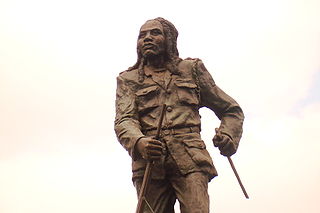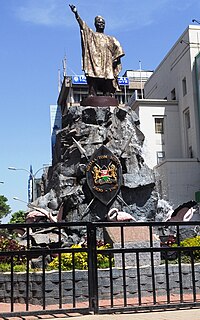Related Research Articles

The Kikuyu are a Bantu ethnic group native to Central Kenya. At a population of 8,148,668 as of 2019, they account for 17.13% of the total population of Kenya, making them the largest ethnic group in Kenya.

Ngũgĩ wa Thiong'o is a Kenyan writer and academic who writes primarily in Gikuyu and who formerly wrote in English. His work includes novels, plays, short stories, and essays, ranging from literary and social criticism to children's literature. He is the founder and editor of the Gikuyu-language journal Mũtĩiri. His short story The Upright Revolution: Or Why Humans Walk Upright, is translated into 100 languages from around the world.

The Kenya African Democratic Union (KADU) was a political party in Kenya. It was founded in 1960 when several leading politicians refused to join Jomo Kenyatta's Kenya African National Union (KANU). It was led by Ronald Ngala who was joined by Moi's Kalenjin Political Alliance, the Masai United Front, the Kenya African Peoples Party, the Coast African Political Union, Masinde Muliro's Baluhya Political Union and the Somali National Front. The separate tribal organisations were to retain their identity and so, from the very start, KADU based its political approach on tribalism. KADU's aim was to defend the interests of the so-called KAMATUSA as well as the British settlers, against the imagined future dominance of the larger Luo and Kikuyu that comprised the majority of KANU's membership, when it became inevitable that Kenya will achieve its independence. The KADU objective was to work towards a multiracial self government within the existing colonial political system. After release of Jomo Kenyatta, KADU was becoming increasingly popular with European settlers and, on the whole, repudiated Kenyatta's leadership. KADU's plan at Lancaster meetings was devised by European supporters, essentially to protect prevailing British settlers land rights.

Dedan Kimathi Waciuri, born Kimathi wa Waciuri in what was then British Kenya, was the senior military and spiritual leader of the Mau Mau Uprising. Widely regarded as a revolutionary leader, he led the armed military struggle against the British colonial regime in Kenya in the 1950s until his capture in 1956 and execution in 1957. Kimathi is credited with leading efforts to create formal military structures within the Mau Mau, and convening a war council in 1953. He, along with Musa Mwariama and Muthoni Kirima, was one of three Field Marshals.

Nyeri is a town situated in the Central Highlands of Kenya. It is the county headquarters of Nyeri County. The town was the central administrative headquarters of the country's former Central Province. Following the dissolution of the former provinces by Kenya's new constitution on 26 August 2010, the city is situated about 150 km north of Kenya's capital Nairobi, in the country's densely populated and fertile Central Highlands, lying between the eastern base of the Aberdare (Nyandarua) Range, which forms part of the eastern end of the Great Rift Valley, and the western slopes of Mount Kenya.

Murang'a County is one of the counties of Kenya's former Central Province. Its largest town and capital is Murang'a, formerly referred to as Fort Hall during the colonial era. It is inhabited mainly by and is considered the home of the Gikuyu, the largest ethnic group in Kenya. The county has a population of 1,056,640.
General Kubu Kubu, born Njagi wa Ikutha, was a Mau Mau leader. His nom de guerre, Kubu Kubu means "heavy thud" and was coined from the thud his feet made because of his heavy build.
Ian Stuart McWalter Henderson, also known as Ian Stewart McWalter Henderson, was a British citizen known for his role in resolving the Mau Mau crisis in Kenya in the late 1950s and for managing the Bahraini General Directorate for State Security Investigations from 1966 to 1998. Henderson was dubbed the Butcher of Bahrain due to torture and the numerous human rights violations that were alleged to have taken place under his command there, especially during 1990s uprising in Bahrain.
Waruhiu Itote, nom de guerreGeneral China, was one of the key leaders of the Mau Mau Uprising (1952–1960) in British Kenya alongside Dedan Kimathi, Stanley Mathenge, Kurito ole Kisio, Musa Mwariama and Muthoni Kirima.
Kamiti Maximum Security Prison is a prison in Nairobi County, Kenya. The prison is within Roysambu Constituency, bordering Kiambu County. Originally named "Kamiti Downs", it sits in the middle of its own 490-hectare (1,200-acre) estates which lie fallow and untended.
Tetu Constituency is an electoral constituency in Kenya. It was established in 1988 and is one of the six constituencies in Nyeri County.
Stanley Mathenge wa Mirugi was a Mau Mau military leader.

Micere Githae Mugo is a playwright, author, activist, instructor and poet from Kenya. She is a literary critic and professor of literature in the Department of African American Studies at Syracuse University. She was forced into exile in 1982 from Kenya during the Daniel Arap Moi dictatorship for activism and moved to teach in Zimbabwe, and later the United States. Mwalimu Mugo teaches Orature, Literature, and Creative Writing. Her publications include six books, a play co-authored with Ngũgĩ wa Thiong'o and three monographs. She has also edited journals and the Zimbabwean school curriculum. The East African Standard listed her among the 100 most influential people in Kenya in 2002.

The Tom Mboya Monument is along Moi Avenue in Nairobi, Kenya. It was erected in 2011 in honour of Tom Mboya, a Kenyan government minister who was assassinated in 1969. The monument stands about twenty meters from where Mboya was murdered.
The Kennedy Airlift was started in 1959 by a 28-year-old Kenyan, Tom Mboya, who sought support for promising Kenyan students to get college and university educations in the United States and Canada. It brought hundreds of students from East Africa from 1959 to 1963 and was supported by many North American educational institutions, foundations, and individuals such as the African American Students Foundation (AASF) and African Americans including Harry Belafonte, Jackie Robinson, Sidney Poitier, and Martin Luther King Jr. It got its popular nickname in September 1960 when Senator John F. Kennedy in a close presidential campaign arranged a $100,000 donation from the Joseph P. Kennedy Jr Foundation to cover airfare for the autumn 1960 group of East African students just as the program was running out of funds.
The Capture of Kimathi was the arrest of noted Mau Mau leader Dedan Kimathi during the Mau Mau Uprising in October 1956. Kimathi had been the field commander of the Mau Mau. He was captured by British police officer Ian Henderson who used intelligence gathered from disgruntled former Mau Mau.
The Kenya Land and Freedom Army (KLFA), also known as the Mau Mau, was a guerrilla army, formed mainly by the people of central and eastern Kenya, dominated by the Kikuyu people. It resisted British colonialism in Kenya from the late 1940s to the early 1960s, culminating in the Mau Mau rebellion from 1952 to 1960. The army was led by Field Marshal Dedan Kimathi.
The Mwakenya Movement was an underground socialist movement in Kenya in the 1980s formed to fight for multi-party democracy.
Kurito ole Kisio was a Mau Mau general who was killed in Narok, Kenya, in 1954. One of the lesser known leaders of the rebellion, Kisio was the highest ranking Mau Mau leader from the Maasai community. He fought alongside Turesh ole Tikani and Muntet ole Nkapiani. Although little is known about him today, Kisio's role in the freedom movement was important because it shows the Mau Mau Uprising was not a Kikuyu-only affair. According to Mau Mau chronicler Karari Njama, ole Kisio was the fourth most powerful man within Mau Mau ranks. He had an army of about 800 fighters operating from Melili Forest in Narok.
References
- ↑ "African Books Collective: Dedan Kĩmathi Speaks". www.africanbookscollective.com. Retrieved 24 May 2020.
- ↑ Kenya: A Prison Diary. Maina wa Kinyatti. BookSurge Press. 2009.
- ↑ "Archived copy". Archived from the original on 25 August 2006. Retrieved 15 October 2006.
{{cite web}}: CS1 maint: archived copy as title (link)